A Comprehensive Review of Renewable Energy Policies in Australia
VerifiedAdded on 2023/06/13
|10
|2296
|123
Literature Review
AI Summary
This literature review examines the renewable energy sector in Australia, focusing on the impact of policies and challenges to growth. It analyzes statistical data and survey results to compare Australia's performance with countries like China, the US, the UK, and Germany. The review highlights the political instability affecting energy policies, the underutilization of renewable resources despite Australia's potential, and the need for new integration policies. It discusses the importance of policy incentives, electricity market investments, and regulatory changes for promoting renewable energy adoption. The review concludes by emphasizing the potential for effective utilization of renewable energies through changes in electricity and employment models, ultimately contributing to a low-investment, sustainable energy future for Australia. Desklib provides access to similar documents and solved assignments for students.
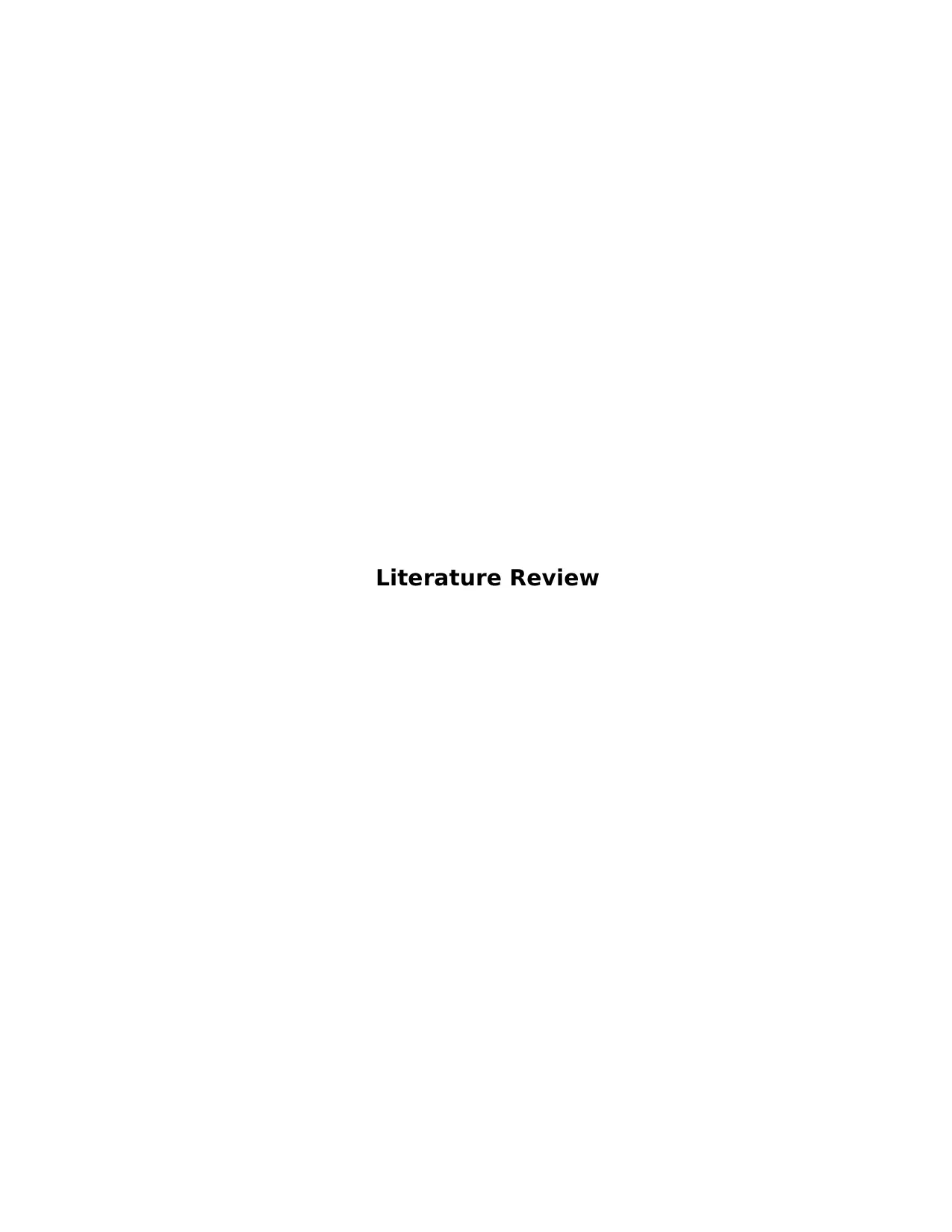
Literature Review
Paraphrase This Document
Need a fresh take? Get an instant paraphrase of this document with our AI Paraphraser
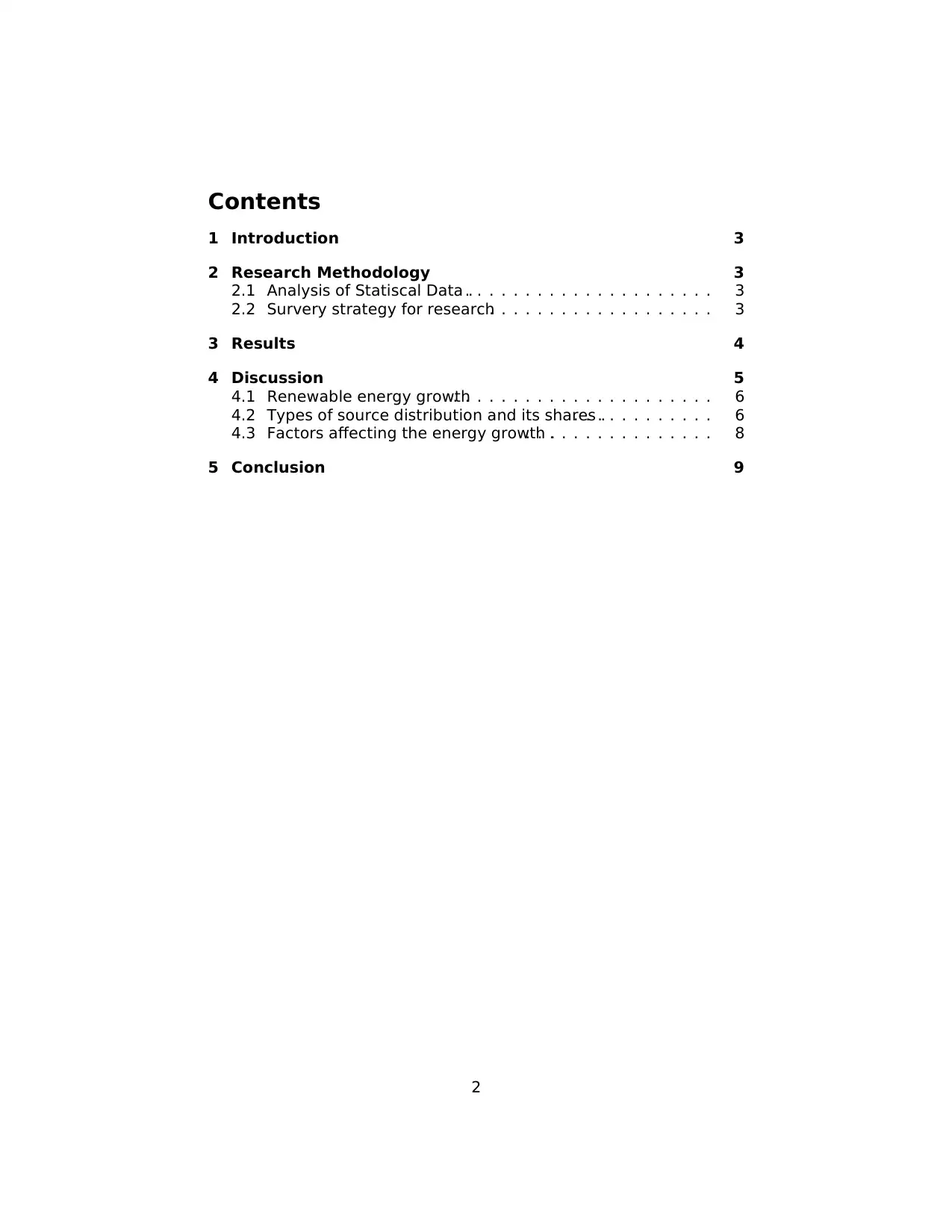
Contents
1 Introduction 3
2 Research Methodology 3
2.1 Analysis of Statiscal Data .. . . . . . . . . . . . . . . . . . . . . 3
2.2 Survery strategy for research. . . . . . . . . . . . . . . . . . . . 3
3 Results 4
4 Discussion 5
4.1 Renewable energy growth. . . . . . . . . . . . . . . . . . . . . . 6
4.2 Types of source distribution and its shares .. . . . . . . . . . . . 6
4.3 Factors affecting the energy growth .. . . . . . . . . . . . . . . . 8
5 Conclusion 9
2
1 Introduction 3
2 Research Methodology 3
2.1 Analysis of Statiscal Data .. . . . . . . . . . . . . . . . . . . . . 3
2.2 Survery strategy for research. . . . . . . . . . . . . . . . . . . . 3
3 Results 4
4 Discussion 5
4.1 Renewable energy growth. . . . . . . . . . . . . . . . . . . . . . 6
4.2 Types of source distribution and its shares .. . . . . . . . . . . . 6
4.3 Factors affecting the energy growth .. . . . . . . . . . . . . . . . 8
5 Conclusion 9
2
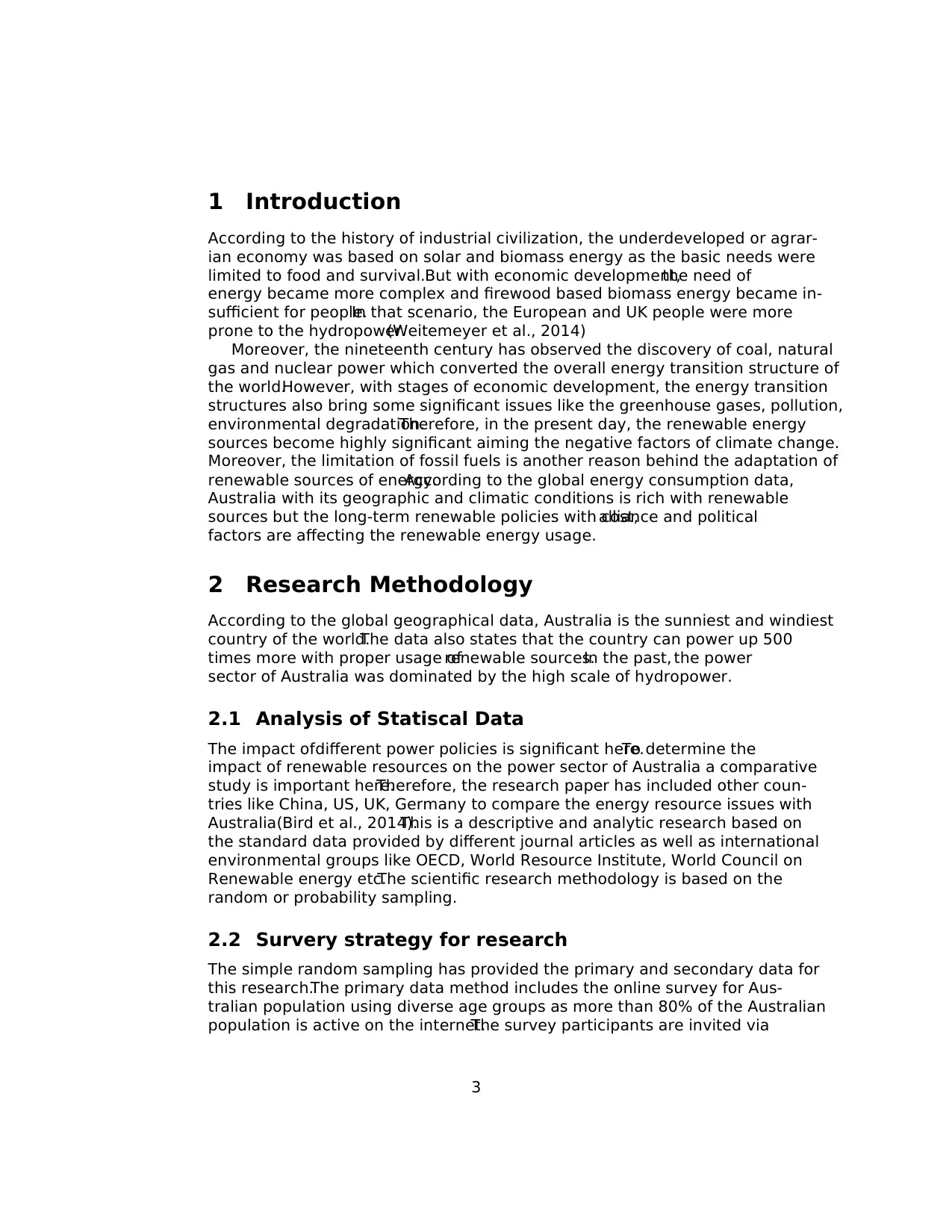
1 Introduction
According to the history of industrial civilization, the underdeveloped or agrar-
ian economy was based on solar and biomass energy as the basic needs were
limited to food and survival.But with economic development,the need of
energy became more complex and firewood based biomass energy became in-
sufficient for people.In that scenario, the European and UK people were more
prone to the hydropower.(Weitemeyer et al., 2014)
Moreover, the nineteenth century has observed the discovery of coal, natural
gas and nuclear power which converted the overall energy transition structure of
the world.However, with stages of economic development, the energy transition
structures also bring some significant issues like the greenhouse gases, pollution,
environmental degradation.Therefore, in the present day, the renewable energy
sources become highly significant aiming the negative factors of climate change.
Moreover, the limitation of fossil fuels is another reason behind the adaptation of
renewable sources of energy.According to the global energy consumption data,
Australia with its geographic and climatic conditions is rich with renewable
sources but the long-term renewable policies with cost,alliance and political
factors are affecting the renewable energy usage.
2 Research Methodology
According to the global geographical data, Australia is the sunniest and windiest
country of the world.The data also states that the country can power up 500
times more with proper usage ofrenewable sources.In the past, the power
sector of Australia was dominated by the high scale of hydropower.
2.1 Analysis of Statiscal Data
The impact ofdifferent power policies is significant here.To determine the
impact of renewable resources on the power sector of Australia a comparative
study is important here.Therefore, the research paper has included other coun-
tries like China, US, UK, Germany to compare the energy resource issues with
Australia(Bird et al., 2014).This is a descriptive and analytic research based on
the standard data provided by different journal articles as well as international
environmental groups like OECD, World Resource Institute, World Council on
Renewable energy etc.The scientific research methodology is based on the
random or probability sampling.
2.2 Survery strategy for research
The simple random sampling has provided the primary and secondary data for
this research.The primary data method includes the online survey for Aus-
tralian population using diverse age groups as more than 80% of the Australian
population is active on the internet.The survey participants are invited via
3
According to the history of industrial civilization, the underdeveloped or agrar-
ian economy was based on solar and biomass energy as the basic needs were
limited to food and survival.But with economic development,the need of
energy became more complex and firewood based biomass energy became in-
sufficient for people.In that scenario, the European and UK people were more
prone to the hydropower.(Weitemeyer et al., 2014)
Moreover, the nineteenth century has observed the discovery of coal, natural
gas and nuclear power which converted the overall energy transition structure of
the world.However, with stages of economic development, the energy transition
structures also bring some significant issues like the greenhouse gases, pollution,
environmental degradation.Therefore, in the present day, the renewable energy
sources become highly significant aiming the negative factors of climate change.
Moreover, the limitation of fossil fuels is another reason behind the adaptation of
renewable sources of energy.According to the global energy consumption data,
Australia with its geographic and climatic conditions is rich with renewable
sources but the long-term renewable policies with cost,alliance and political
factors are affecting the renewable energy usage.
2 Research Methodology
According to the global geographical data, Australia is the sunniest and windiest
country of the world.The data also states that the country can power up 500
times more with proper usage ofrenewable sources.In the past, the power
sector of Australia was dominated by the high scale of hydropower.
2.1 Analysis of Statiscal Data
The impact ofdifferent power policies is significant here.To determine the
impact of renewable resources on the power sector of Australia a comparative
study is important here.Therefore, the research paper has included other coun-
tries like China, US, UK, Germany to compare the energy resource issues with
Australia(Bird et al., 2014).This is a descriptive and analytic research based on
the standard data provided by different journal articles as well as international
environmental groups like OECD, World Resource Institute, World Council on
Renewable energy etc.The scientific research methodology is based on the
random or probability sampling.
2.2 Survery strategy for research
The simple random sampling has provided the primary and secondary data for
this research.The primary data method includes the online survey for Aus-
tralian population using diverse age groups as more than 80% of the Australian
population is active on the internet.The survey participants are invited via
3
⊘ This is a preview!⊘
Do you want full access?
Subscribe today to unlock all pages.

Trusted by 1+ million students worldwide
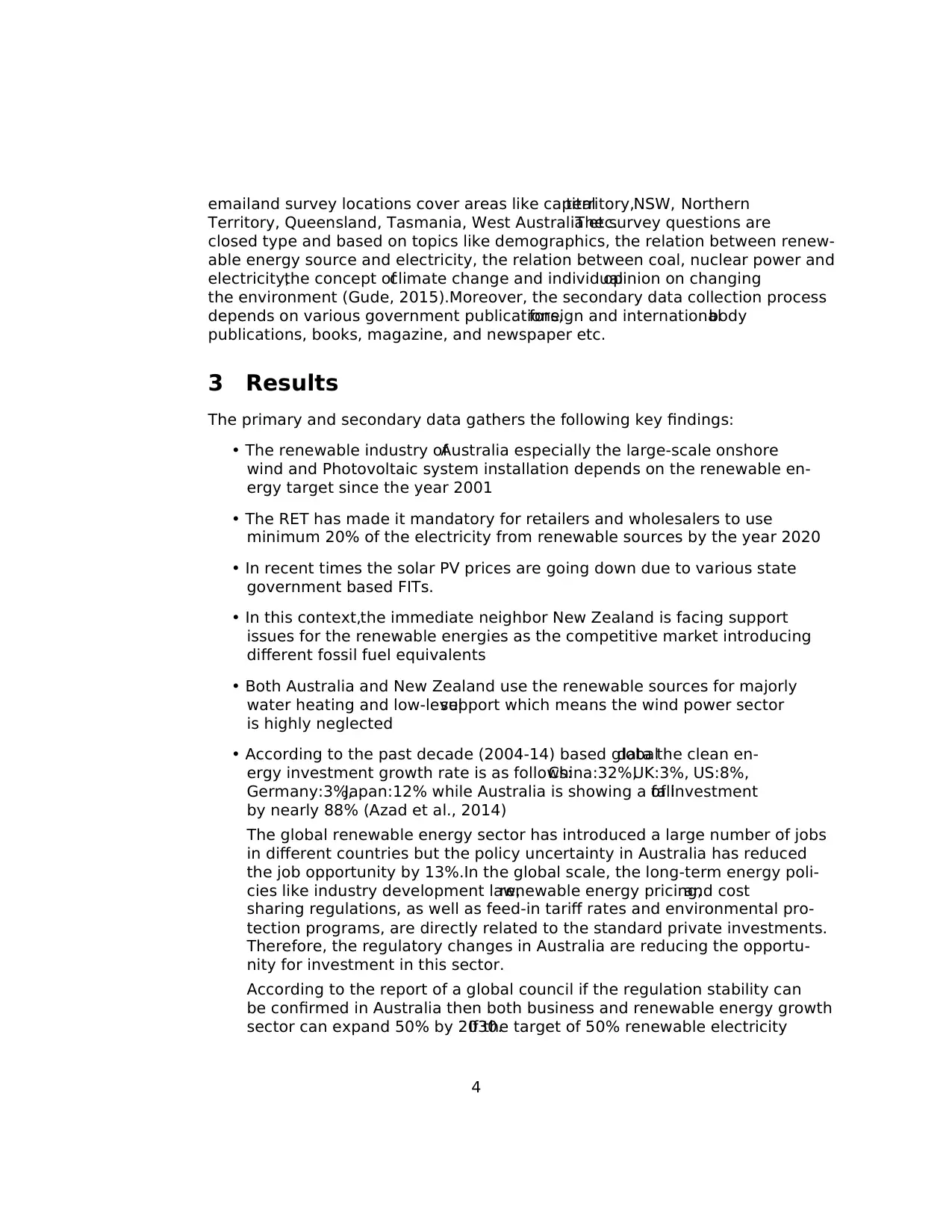
emailand survey locations cover areas like capitalterritory,NSW, Northern
Territory, Queensland, Tasmania, West Australia etc.The survey questions are
closed type and based on topics like demographics, the relation between renew-
able energy source and electricity, the relation between coal, nuclear power and
electricity,the concept ofclimate change and individualopinion on changing
the environment (Gude, 2015).Moreover, the secondary data collection process
depends on various government publications,foreign and internationalbody
publications, books, magazine, and newspaper etc.
3 Results
The primary and secondary data gathers the following key findings:
• The renewable industry ofAustralia especially the large-scale onshore
wind and Photovoltaic system installation depends on the renewable en-
ergy target since the year 2001
• The RET has made it mandatory for retailers and wholesalers to use
minimum 20% of the electricity from renewable sources by the year 2020
• In recent times the solar PV prices are going down due to various state
government based FITs.
• In this context,the immediate neighbor New Zealand is facing support
issues for the renewable energies as the competitive market introducing
different fossil fuel equivalents
• Both Australia and New Zealand use the renewable sources for majorly
water heating and low-levelsupport which means the wind power sector
is highly neglected
• According to the past decade (2004-14) based globaldata the clean en-
ergy investment growth rate is as follows:China:32%,UK:3%, US:8%,
Germany:3%,Japan:12% while Australia is showing a fallof investment
by nearly 88% (Azad et al., 2014)
The global renewable energy sector has introduced a large number of jobs
in different countries but the policy uncertainty in Australia has reduced
the job opportunity by 13%.In the global scale, the long-term energy poli-
cies like industry development law,renewable energy pricing,and cost
sharing regulations, as well as feed-in tariff rates and environmental pro-
tection programs, are directly related to the standard private investments.
Therefore, the regulatory changes in Australia are reducing the opportu-
nity for investment in this sector.
According to the report of a global council if the regulation stability can
be confirmed in Australia then both business and renewable energy growth
sector can expand 50% by 2030.If the target of 50% renewable electricity
4
Territory, Queensland, Tasmania, West Australia etc.The survey questions are
closed type and based on topics like demographics, the relation between renew-
able energy source and electricity, the relation between coal, nuclear power and
electricity,the concept ofclimate change and individualopinion on changing
the environment (Gude, 2015).Moreover, the secondary data collection process
depends on various government publications,foreign and internationalbody
publications, books, magazine, and newspaper etc.
3 Results
The primary and secondary data gathers the following key findings:
• The renewable industry ofAustralia especially the large-scale onshore
wind and Photovoltaic system installation depends on the renewable en-
ergy target since the year 2001
• The RET has made it mandatory for retailers and wholesalers to use
minimum 20% of the electricity from renewable sources by the year 2020
• In recent times the solar PV prices are going down due to various state
government based FITs.
• In this context,the immediate neighbor New Zealand is facing support
issues for the renewable energies as the competitive market introducing
different fossil fuel equivalents
• Both Australia and New Zealand use the renewable sources for majorly
water heating and low-levelsupport which means the wind power sector
is highly neglected
• According to the past decade (2004-14) based globaldata the clean en-
ergy investment growth rate is as follows:China:32%,UK:3%, US:8%,
Germany:3%,Japan:12% while Australia is showing a fallof investment
by nearly 88% (Azad et al., 2014)
The global renewable energy sector has introduced a large number of jobs
in different countries but the policy uncertainty in Australia has reduced
the job opportunity by 13%.In the global scale, the long-term energy poli-
cies like industry development law,renewable energy pricing,and cost
sharing regulations, as well as feed-in tariff rates and environmental pro-
tection programs, are directly related to the standard private investments.
Therefore, the regulatory changes in Australia are reducing the opportu-
nity for investment in this sector.
According to the report of a global council if the regulation stability can
be confirmed in Australia then both business and renewable energy growth
sector can expand 50% by 2030.If the target of 50% renewable electricity
4
Paraphrase This Document
Need a fresh take? Get an instant paraphrase of this document with our AI Paraphraser
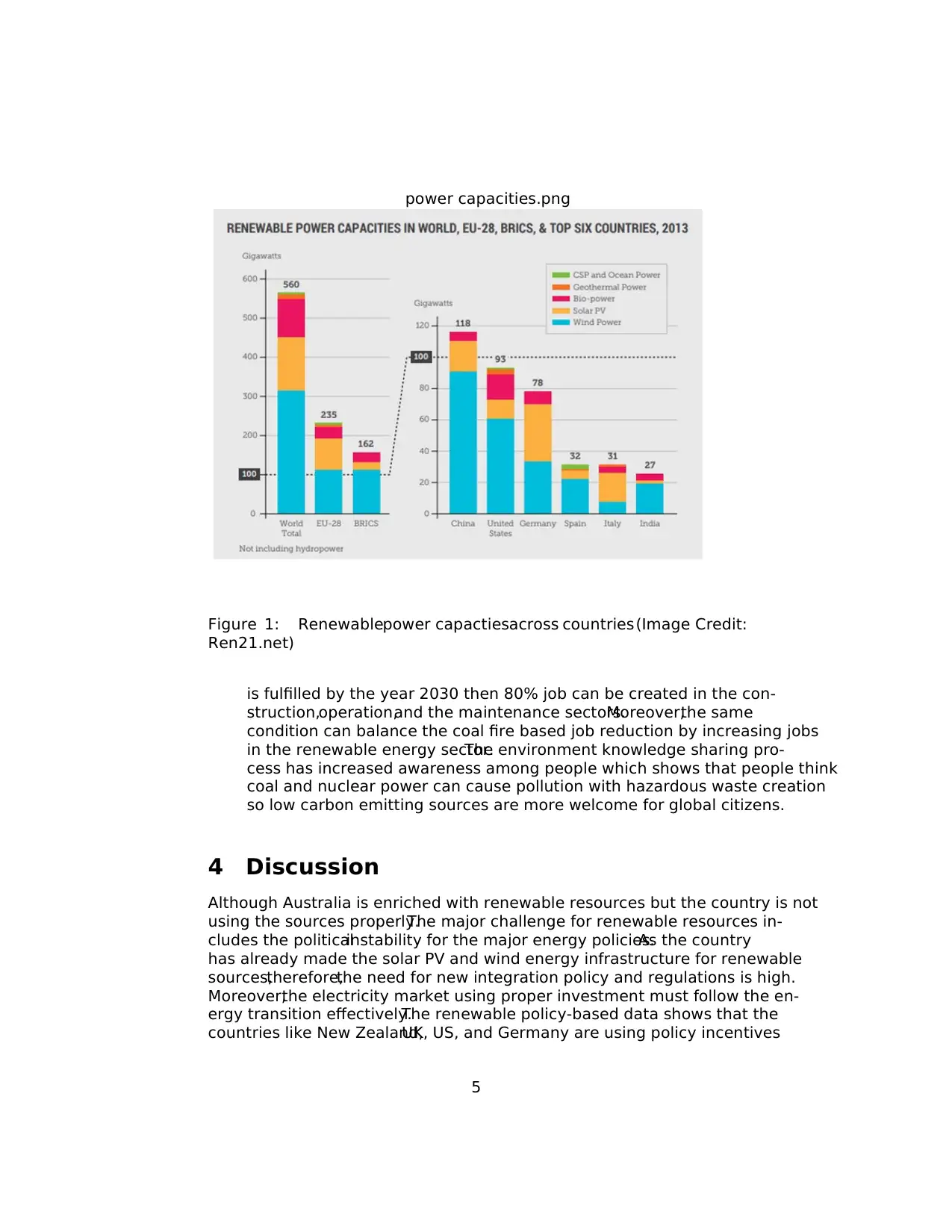
power capacities.png
Figure 1: Renewablepower capactiesacross countries(Image Credit:
Ren21.net)
is fulfilled by the year 2030 then 80% job can be created in the con-
struction,operation,and the maintenance sectors.Moreover,the same
condition can balance the coal fire based job reduction by increasing jobs
in the renewable energy sector.The environment knowledge sharing pro-
cess has increased awareness among people which shows that people think
coal and nuclear power can cause pollution with hazardous waste creation
so low carbon emitting sources are more welcome for global citizens.
4 Discussion
Although Australia is enriched with renewable resources but the country is not
using the sources properly.The major challenge for renewable resources in-
cludes the politicalinstability for the major energy policies.As the country
has already made the solar PV and wind energy infrastructure for renewable
sources,therefore,the need for new integration policy and regulations is high.
Moreover,the electricity market using proper investment must follow the en-
ergy transition effectively.The renewable policy-based data shows that the
countries like New Zealand,UK, US, and Germany are using policy incentives
5
Figure 1: Renewablepower capactiesacross countries(Image Credit:
Ren21.net)
is fulfilled by the year 2030 then 80% job can be created in the con-
struction,operation,and the maintenance sectors.Moreover,the same
condition can balance the coal fire based job reduction by increasing jobs
in the renewable energy sector.The environment knowledge sharing pro-
cess has increased awareness among people which shows that people think
coal and nuclear power can cause pollution with hazardous waste creation
so low carbon emitting sources are more welcome for global citizens.
4 Discussion
Although Australia is enriched with renewable resources but the country is not
using the sources properly.The major challenge for renewable resources in-
cludes the politicalinstability for the major energy policies.As the country
has already made the solar PV and wind energy infrastructure for renewable
sources,therefore,the need for new integration policy and regulations is high.
Moreover,the electricity market using proper investment must follow the en-
ergy transition effectively.The renewable policy-based data shows that the
countries like New Zealand,UK, US, and Germany are using policy incentives
5
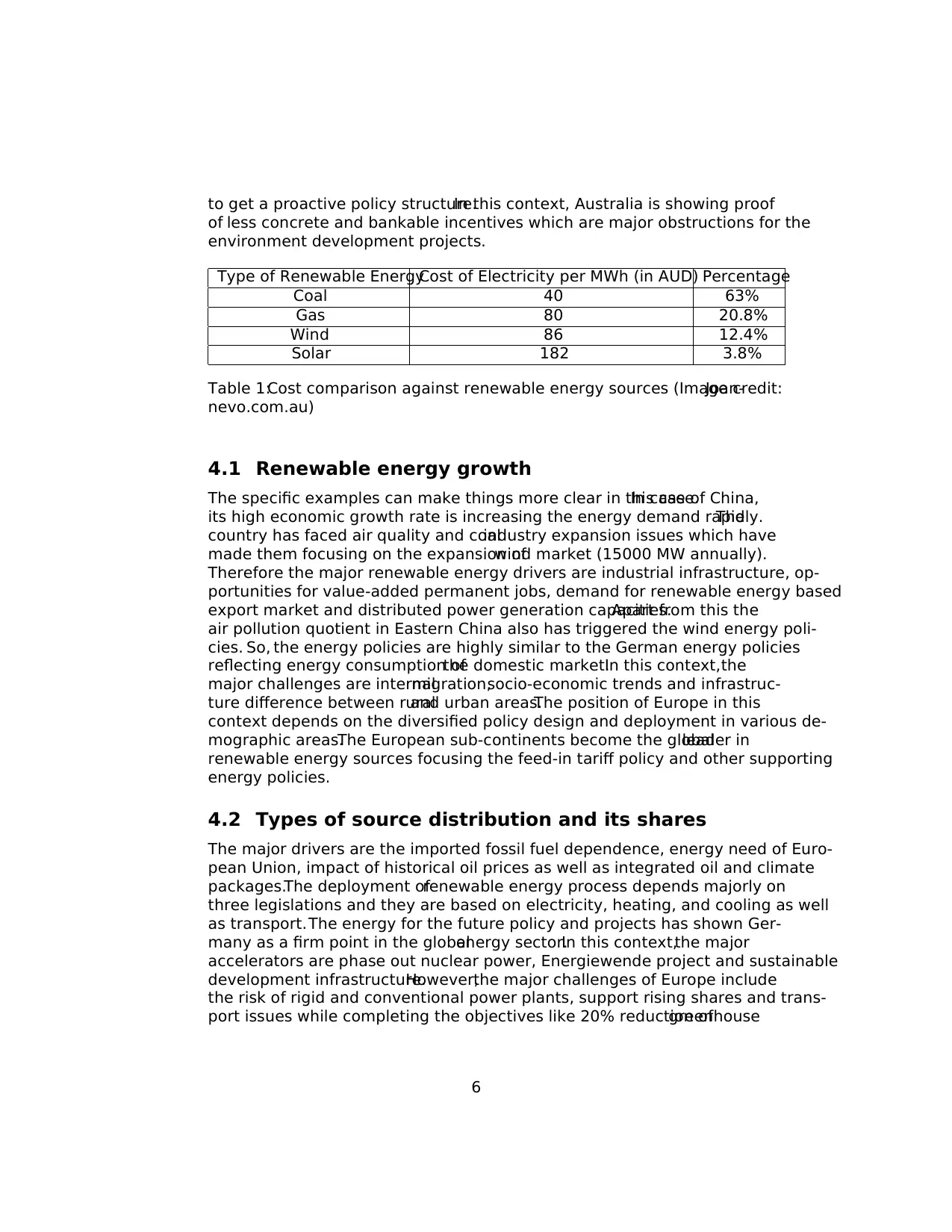
to get a proactive policy structure.In this context, Australia is showing proof
of less concrete and bankable incentives which are major obstructions for the
environment development projects.
Type of Renewable EnergyCost of Electricity per MWh (in AUD) Percentage
Coal 40 63%
Gas 80 20.8%
Wind 86 12.4%
Solar 182 3.8%
Table 1:Cost comparison against renewable energy sources (Image credit:Joan-
nevo.com.au)
4.1 Renewable energy growth
The specific examples can make things more clear in this case.In case of China,
its high economic growth rate is increasing the energy demand rapidly.The
country has faced air quality and coalindustry expansion issues which have
made them focusing on the expansion ofwind market (15000 MW annually).
Therefore the major renewable energy drivers are industrial infrastructure, op-
portunities for value-added permanent jobs, demand for renewable energy based
export market and distributed power generation capacities.Apart from this the
air pollution quotient in Eastern China also has triggered the wind energy poli-
cies. So, the energy policies are highly similar to the German energy policies
reflecting energy consumption ofthe domestic market.In this context,the
major challenges are internalmigration,socio-economic trends and infrastruc-
ture difference between ruraland urban areas.The position of Europe in this
context depends on the diversified policy design and deployment in various de-
mographic areas.The European sub-continents become the globalleader in
renewable energy sources focusing the feed-in tariff policy and other supporting
energy policies.
4.2 Types of source distribution and its shares
The major drivers are the imported fossil fuel dependence, energy need of Euro-
pean Union, impact of historical oil prices as well as integrated oil and climate
packages.The deployment ofrenewable energy process depends majorly on
three legislations and they are based on electricity, heating, and cooling as well
as transport.The energy for the future policy and projects has shown Ger-
many as a firm point in the globalenergy sector.In this context,the major
accelerators are phase out nuclear power, Energiewende project and sustainable
development infrastructure.However,the major challenges of Europe include
the risk of rigid and conventional power plants, support rising shares and trans-
port issues while completing the objectives like 20% reduction ofgreenhouse
6
of less concrete and bankable incentives which are major obstructions for the
environment development projects.
Type of Renewable EnergyCost of Electricity per MWh (in AUD) Percentage
Coal 40 63%
Gas 80 20.8%
Wind 86 12.4%
Solar 182 3.8%
Table 1:Cost comparison against renewable energy sources (Image credit:Joan-
nevo.com.au)
4.1 Renewable energy growth
The specific examples can make things more clear in this case.In case of China,
its high economic growth rate is increasing the energy demand rapidly.The
country has faced air quality and coalindustry expansion issues which have
made them focusing on the expansion ofwind market (15000 MW annually).
Therefore the major renewable energy drivers are industrial infrastructure, op-
portunities for value-added permanent jobs, demand for renewable energy based
export market and distributed power generation capacities.Apart from this the
air pollution quotient in Eastern China also has triggered the wind energy poli-
cies. So, the energy policies are highly similar to the German energy policies
reflecting energy consumption ofthe domestic market.In this context,the
major challenges are internalmigration,socio-economic trends and infrastruc-
ture difference between ruraland urban areas.The position of Europe in this
context depends on the diversified policy design and deployment in various de-
mographic areas.The European sub-continents become the globalleader in
renewable energy sources focusing the feed-in tariff policy and other supporting
energy policies.
4.2 Types of source distribution and its shares
The major drivers are the imported fossil fuel dependence, energy need of Euro-
pean Union, impact of historical oil prices as well as integrated oil and climate
packages.The deployment ofrenewable energy process depends majorly on
three legislations and they are based on electricity, heating, and cooling as well
as transport.The energy for the future policy and projects has shown Ger-
many as a firm point in the globalenergy sector.In this context,the major
accelerators are phase out nuclear power, Energiewende project and sustainable
development infrastructure.However,the major challenges of Europe include
the risk of rigid and conventional power plants, support rising shares and trans-
port issues while completing the objectives like 20% reduction ofgreenhouse
6
⊘ This is a preview!⊘
Do you want full access?
Subscribe today to unlock all pages.

Trusted by 1+ million students worldwide
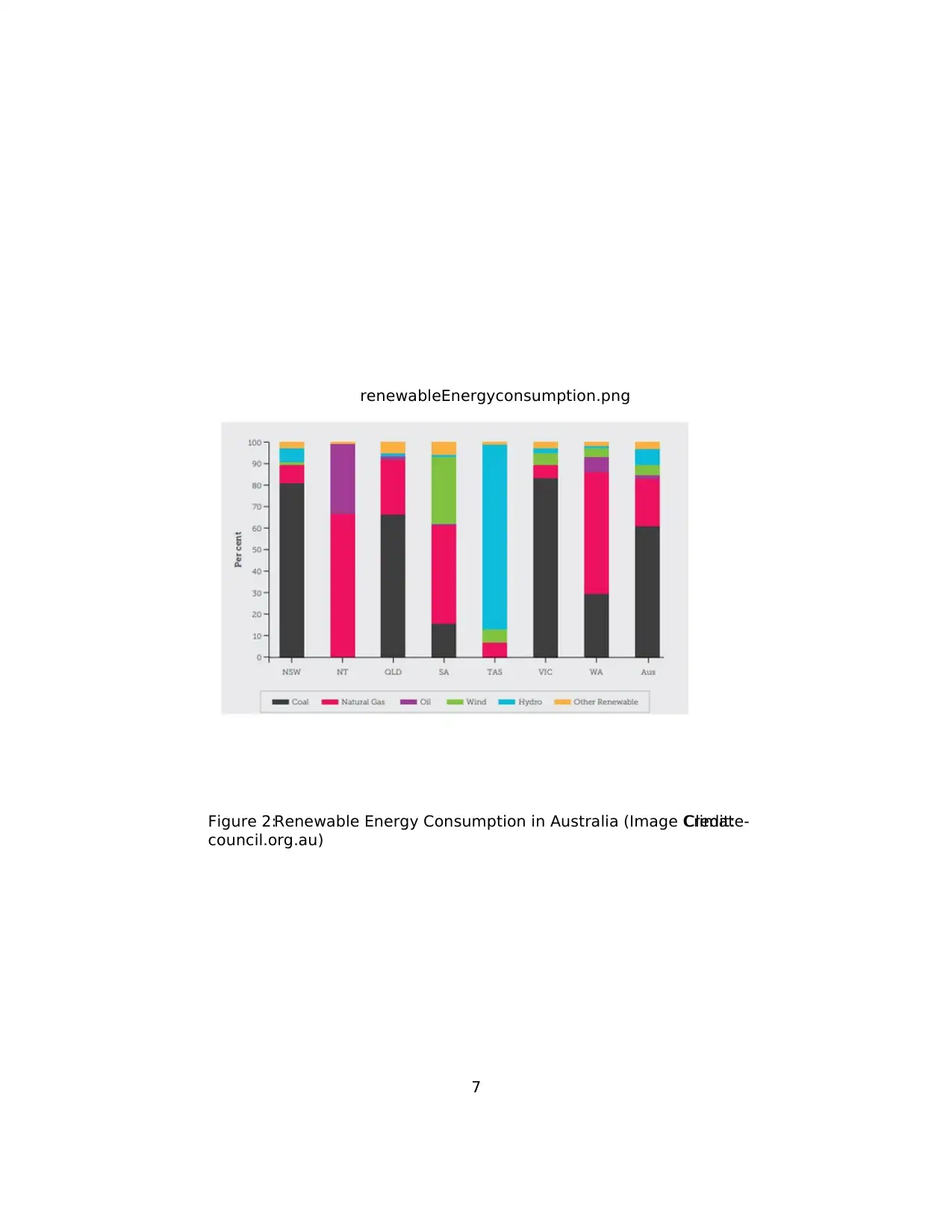
renewableEnergyconsumption.png
Figure 2:Renewable Energy Consumption in Australia (Image Credit:Climate-
council.org.au)
7
Figure 2:Renewable Energy Consumption in Australia (Image Credit:Climate-
council.org.au)
7
Paraphrase This Document
Need a fresh take? Get an instant paraphrase of this document with our AI Paraphraser
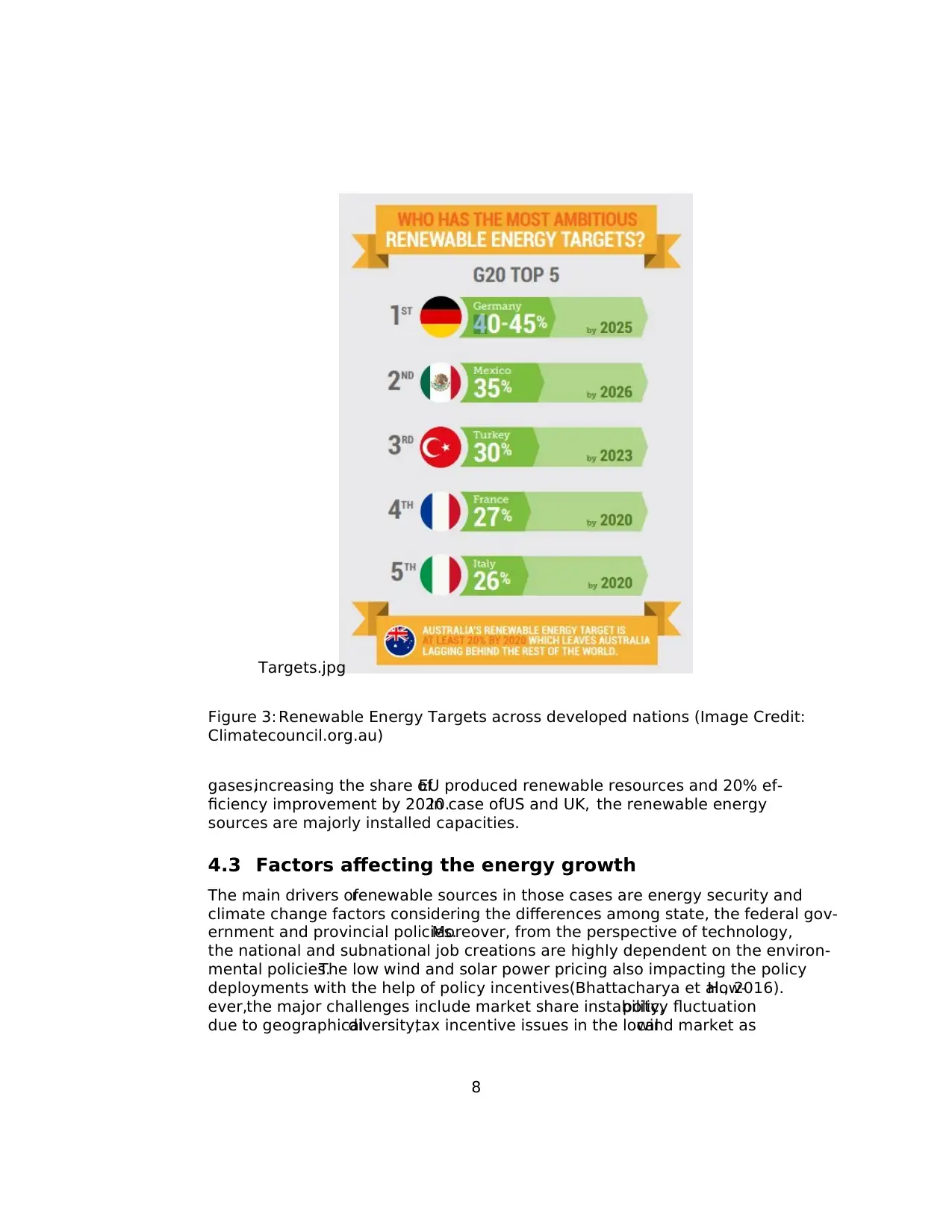
Targets.jpg
Figure 3: Renewable Energy Targets across developed nations (Image Credit:
Climatecouncil.org.au)
gases,increasing the share ofEU produced renewable resources and 20% ef-
ficiency improvement by 2020.In case ofUS and UK, the renewable energy
sources are majorly installed capacities.
4.3 Factors affecting the energy growth
The main drivers ofrenewable sources in those cases are energy security and
climate change factors considering the differences among state, the federal gov-
ernment and provincial policies.Moreover, from the perspective of technology,
the national and subnational job creations are highly dependent on the environ-
mental policies.The low wind and solar power pricing also impacting the policy
deployments with the help of policy incentives(Bhattacharya et al., 2016).How-
ever,the major challenges include market share instability,policy fluctuation
due to geographicaldiversity,tax incentive issues in the localwind market as
8
Figure 3: Renewable Energy Targets across developed nations (Image Credit:
Climatecouncil.org.au)
gases,increasing the share ofEU produced renewable resources and 20% ef-
ficiency improvement by 2020.In case ofUS and UK, the renewable energy
sources are majorly installed capacities.
4.3 Factors affecting the energy growth
The main drivers ofrenewable sources in those cases are energy security and
climate change factors considering the differences among state, the federal gov-
ernment and provincial policies.Moreover, from the perspective of technology,
the national and subnational job creations are highly dependent on the environ-
mental policies.The low wind and solar power pricing also impacting the policy
deployments with the help of policy incentives(Bhattacharya et al., 2016).How-
ever,the major challenges include market share instability,policy fluctuation
due to geographicaldiversity,tax incentive issues in the localwind market as
8
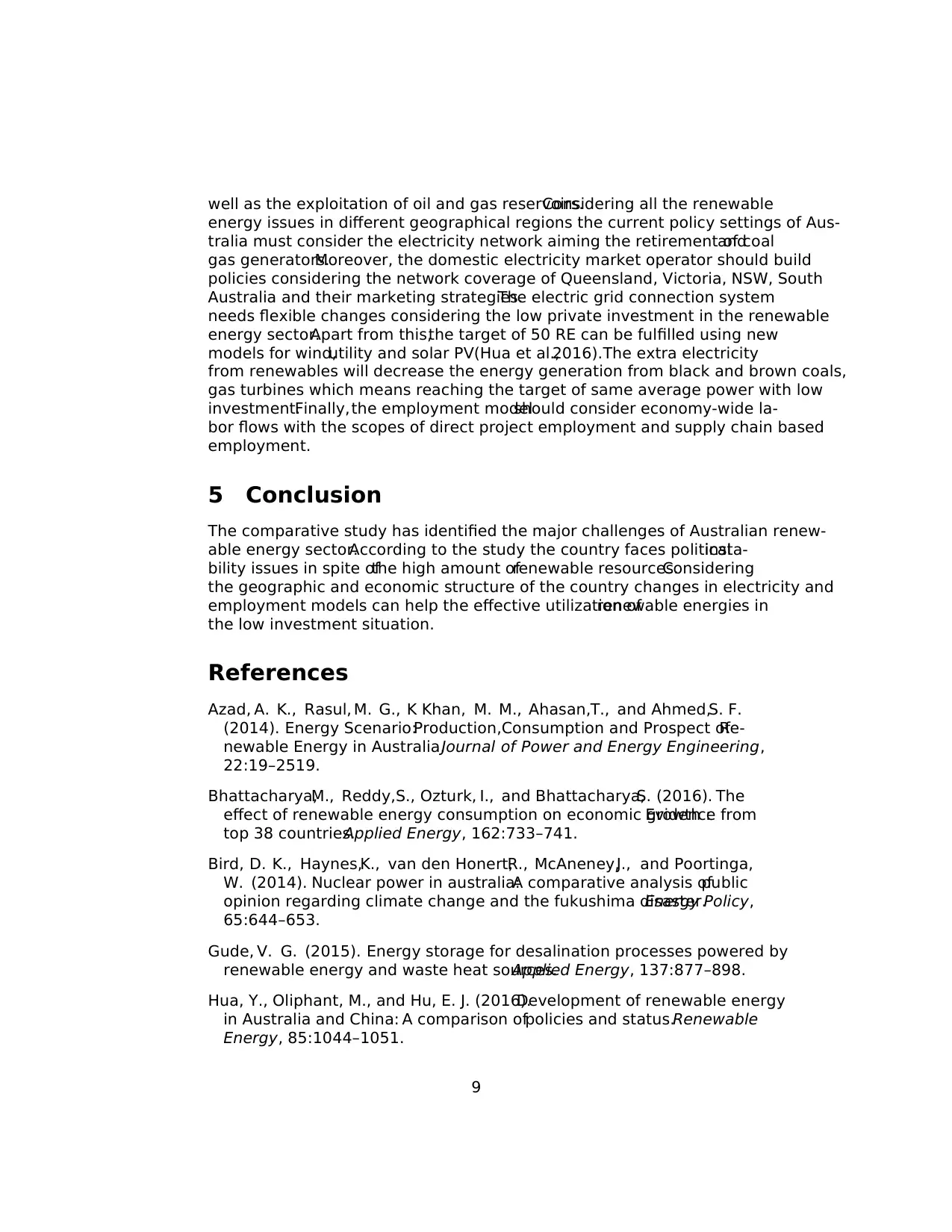
well as the exploitation of oil and gas reservoirs.Considering all the renewable
energy issues in different geographical regions the current policy settings of Aus-
tralia must consider the electricity network aiming the retirement of coaland
gas generators.Moreover, the domestic electricity market operator should build
policies considering the network coverage of Queensland, Victoria, NSW, South
Australia and their marketing strategies.The electric grid connection system
needs flexible changes considering the low private investment in the renewable
energy sector.Apart from this,the target of 50 RE can be fulfilled using new
models for wind,utility and solar PV(Hua et al.,2016).The extra electricity
from renewables will decrease the energy generation from black and brown coals,
gas turbines which means reaching the target of same average power with low
investment.Finally,the employment modelshould consider economy-wide la-
bor flows with the scopes of direct project employment and supply chain based
employment.
5 Conclusion
The comparative study has identified the major challenges of Australian renew-
able energy sector.According to the study the country faces politicalinsta-
bility issues in spite ofthe high amount ofrenewable resources.Considering
the geographic and economic structure of the country changes in electricity and
employment models can help the effective utilization ofrenewable energies in
the low investment situation.
References
Azad, A. K., Rasul, M. G., K Khan, M. M., Ahasan,T., and Ahmed,S. F.
(2014). Energy Scenario:Production,Consumption and Prospect ofRe-
newable Energy in Australia.Journal of Power and Energy Engineering,
22:19–2519.
Bhattacharya,M., Reddy,S., Ozturk, I., and Bhattacharya,S. (2016). The
effect of renewable energy consumption on economic growth :Evidence from
top 38 countries.Applied Energy, 162:733–741.
Bird, D. K., Haynes,K., van den Honert,R., McAneney,J., and Poortinga,
W. (2014). Nuclear power in australia:A comparative analysis ofpublic
opinion regarding climate change and the fukushima disaster.Energy Policy,
65:644–653.
Gude, V. G. (2015). Energy storage for desalination processes powered by
renewable energy and waste heat sources.Applied Energy, 137:877–898.
Hua, Y., Oliphant, M., and Hu, E. J. (2016).Development of renewable energy
in Australia and China: A comparison ofpolicies and status.Renewable
Energy, 85:1044–1051.
9
energy issues in different geographical regions the current policy settings of Aus-
tralia must consider the electricity network aiming the retirement of coaland
gas generators.Moreover, the domestic electricity market operator should build
policies considering the network coverage of Queensland, Victoria, NSW, South
Australia and their marketing strategies.The electric grid connection system
needs flexible changes considering the low private investment in the renewable
energy sector.Apart from this,the target of 50 RE can be fulfilled using new
models for wind,utility and solar PV(Hua et al.,2016).The extra electricity
from renewables will decrease the energy generation from black and brown coals,
gas turbines which means reaching the target of same average power with low
investment.Finally,the employment modelshould consider economy-wide la-
bor flows with the scopes of direct project employment and supply chain based
employment.
5 Conclusion
The comparative study has identified the major challenges of Australian renew-
able energy sector.According to the study the country faces politicalinsta-
bility issues in spite ofthe high amount ofrenewable resources.Considering
the geographic and economic structure of the country changes in electricity and
employment models can help the effective utilization ofrenewable energies in
the low investment situation.
References
Azad, A. K., Rasul, M. G., K Khan, M. M., Ahasan,T., and Ahmed,S. F.
(2014). Energy Scenario:Production,Consumption and Prospect ofRe-
newable Energy in Australia.Journal of Power and Energy Engineering,
22:19–2519.
Bhattacharya,M., Reddy,S., Ozturk, I., and Bhattacharya,S. (2016). The
effect of renewable energy consumption on economic growth :Evidence from
top 38 countries.Applied Energy, 162:733–741.
Bird, D. K., Haynes,K., van den Honert,R., McAneney,J., and Poortinga,
W. (2014). Nuclear power in australia:A comparative analysis ofpublic
opinion regarding climate change and the fukushima disaster.Energy Policy,
65:644–653.
Gude, V. G. (2015). Energy storage for desalination processes powered by
renewable energy and waste heat sources.Applied Energy, 137:877–898.
Hua, Y., Oliphant, M., and Hu, E. J. (2016).Development of renewable energy
in Australia and China: A comparison ofpolicies and status.Renewable
Energy, 85:1044–1051.
9
⊘ This is a preview!⊘
Do you want full access?
Subscribe today to unlock all pages.

Trusted by 1+ million students worldwide
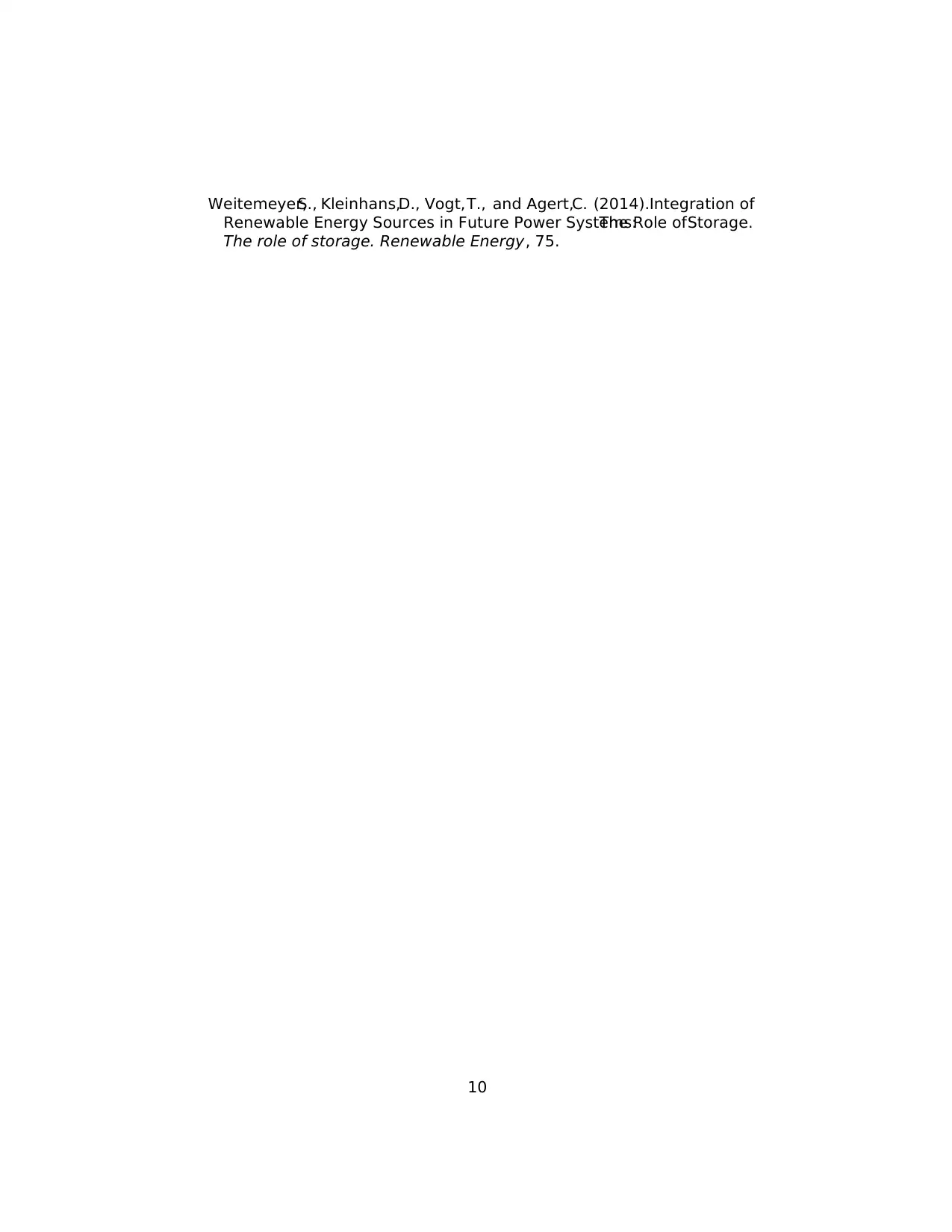
Weitemeyer,S., Kleinhans,D., Vogt,T., and Agert,C. (2014).Integration of
Renewable Energy Sources in Future Power Systems:The Role ofStorage.
The role of storage. Renewable Energy, 75.
10
Renewable Energy Sources in Future Power Systems:The Role ofStorage.
The role of storage. Renewable Energy, 75.
10
1 out of 10
Related Documents
Your All-in-One AI-Powered Toolkit for Academic Success.
+13062052269
info@desklib.com
Available 24*7 on WhatsApp / Email
![[object Object]](/_next/static/media/star-bottom.7253800d.svg)
Unlock your academic potential
Copyright © 2020–2025 A2Z Services. All Rights Reserved. Developed and managed by ZUCOL.





